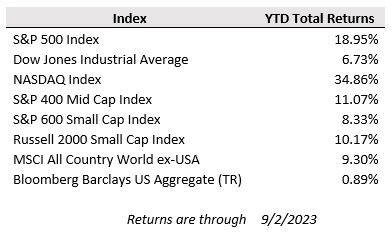U.S. equity markets recorded strong gains last week as economic data continued to point to resilient yet cooling market conditions, including another well-received monthly jobs report. The recent run of not-too-hot and not-too-cold economic data has played into the growing market optimism for a goldilocks soft-landing scenario wherein inflation can be brought under control without the central bank pushing the economy into recession. For the week, the S&P 500 rose 2.5%, while the Dow Jones and Nasdaq Composite notched gains of 1.4% and 3.2%, respectively.
The August jobs report showed surprisingly solid payroll gains with 187k net jobs added to the economy during the month against the consensus economist forecast for a 170k increase. Despite the upside surprise, several aspects of the report indicated sustained cooling of the overtight labor market including an uptick in the unemployment rate from 3.5% to 3.8% and a dip in wage growth to 4.3% year-over-year from 4.4% in July. Encouragingly, the uptick in the unemployment rate was almost entirely driven by a notable increase in the labor force rather than from a large increase in layoffs. The only real negative from the report was a large downward revision to the prior two-month job gains totaling 110k, but the overall twelve-month trend in payroll additions remains sound as the labor market has gradually loosened but maintained its footing.
In response to the jobs report, Federal Reserve Governor Chris Waller commented that the incoming data is looking “pretty good” in favor of a soft-landing scenario, but also suggested that policymakers will need to see “a couple of months along this trajectory” before calling an end to rate hikes. Waller’s comments also echo the improving sentiment among corporate executives regarding the economic outlook. According to FactSet, the number of companies in the S&P 500 that mentioned “recession” during their quarterly earnings calls fell to 62 in the second quarter from 113 in the first quarter. It was the fourth consecutive quarterly decline in recession mentions after peaking at 238 in the second quarter of 2022.
While recent economic data has been encouragingly resilient, inflation data may also prove to be more stubborn than expected, requiring higher rates for longer. The potential for upside inflation shocks could also introduce volatility into markets that have extrapolated out sustained positive economic momentum and moderating inflation. Today oil prices are pushing to their highest levels since late last year on news that Saudi Arabia is unilaterally extending production cuts by another three months. WTI crude oil prices are now up over 20% in the last three months.
In the light schedule of economic releases and corporate news in the week ahead, market participants will be monitoring press coverage of the negotiations between the United Auto Workers (UAW) labor union and the Detroit automakers. There is growing risk of an industrywide strike of roughly 150k workers when their current labor contract expires on September 14. The UAW is seeking a 46% pay increase along with concessions on hours and a restoration of pensions. While unions represent a small percentage of U.S. workers (11.3% in 2022 per the Bureau of Labor Statistics), the heightened union activity and headlines this summer highlight the continued upward pressure on wages following years of elevated inflation.


